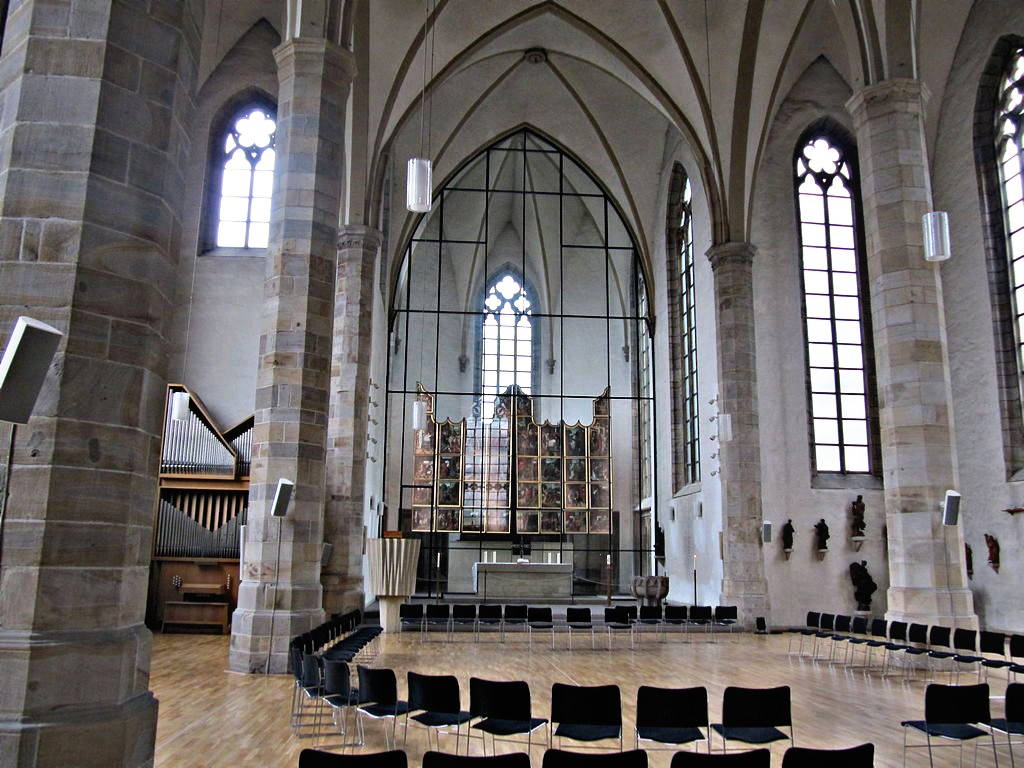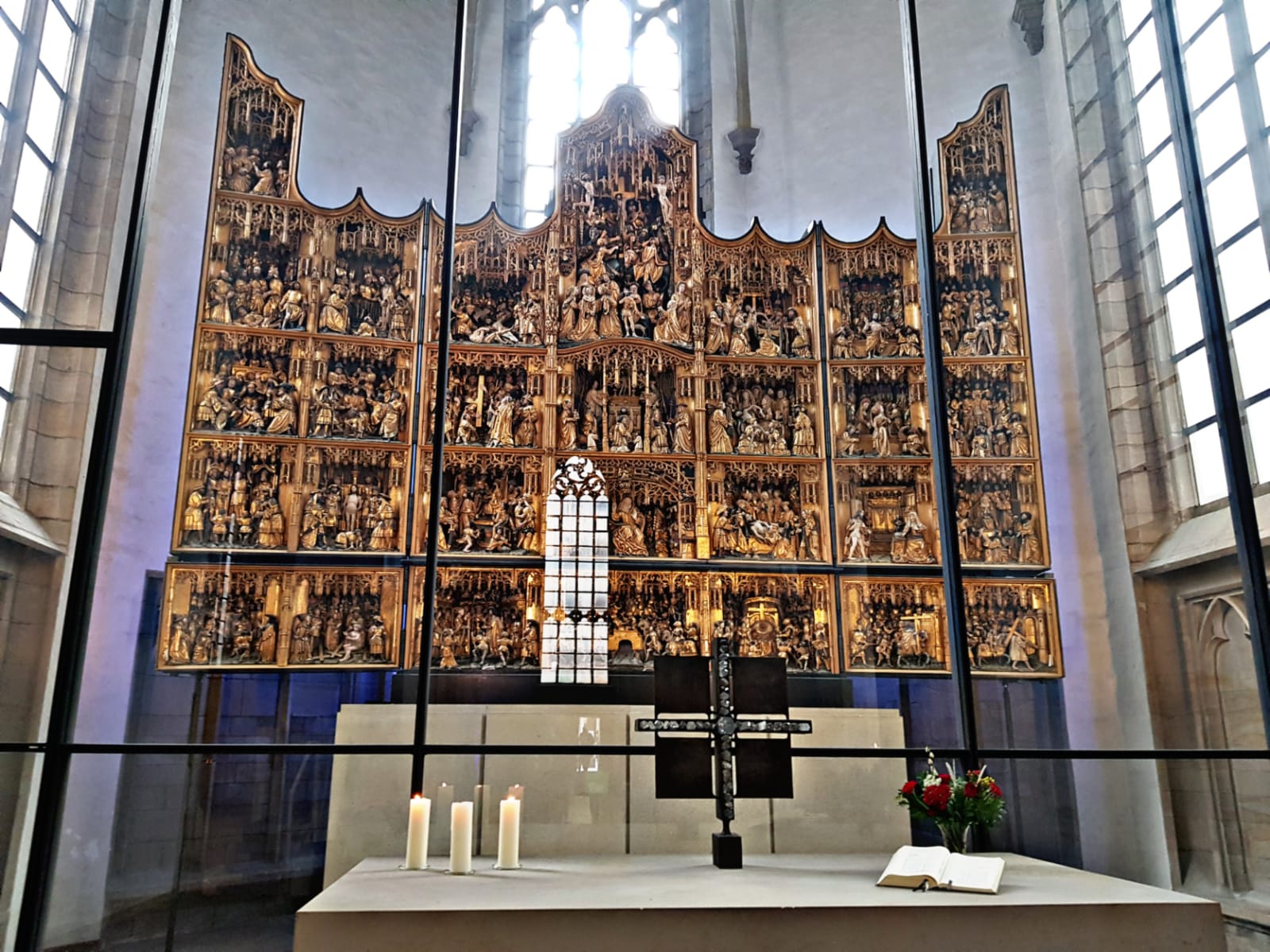By Carol Naidu from India,
The Dortmund Petrikirche (St. Petri church) is one of the four medieval town churches of the Dortmund city center. It was built in 1322 as a gothical hall church and lies in the western part of downtown.
On 2nd November 2019, I attended my very first international service (outside of India) in Petrikirche.
Rachel asked me, that whether am I interested in attending church service on Saturday at Petrikirche? I said, “yes, why not?” and I was very excited. It was almost 18.00 pm in the evening, I heard a very loud noise of a ringing bell, out of curiosity I asked Rachel, “what sound is that? And why are they making this noise?” Rachel replied me, “they are telling people, by ringing the bell, that the service is about to start.” At first, I was astonished because my whole life I believed that bells are just for the decoration and ringing of a bell was a myth. I entered Petrikirche and my very first reaction was like wow! It was the most beautiful church with delightful interior, that I have ever seen. The people and the atmosphere in the church was so welcoming and friendly. I was amazed by the worship that took place in the church, it was in German language, even though I didn’t understand any of it but I could still feel Gods presence in that church.
Despite of the moving history with many destructions, the Dortmund Petrikirche has been reconstructed in its original architectural style. Earthquakes, storms and lightning strikes caused damage to tower and central ship again and again in the course of history. After total destruction in 1759, St. Petri was finally rebuilt again, with classical baroque elements and lofts. On 23 May 1943, with the air raid on Dortmund, St. Petri was destroyed again up to the foundation walls. Fortunately, the alter remained undestroyed, due to its evacuation and is called as, “The Golden Miracle” or “The Golden Wonder”. It’s like a cupboard and depending on which door you open, it will form a different picture in the front with some information, representing the different religious stories. Dortmund Petrikirche was again rebuilt in their original form from 1954 to 1966.
The Golden Miracle of Westphalia is an Antwerp retable from 1521.
With a height of 5.65 meters and a width of 7.40 meters with wing doors open, the Dortmund Carving Altar is considered to be the largest surviving Antwerp altar. The retable is equipped with two pairs of wings, the interior of which is also plastically carved.
The winged altar is opened differently during the church year and then shows a different representation to the front side. During holy week, the retable is in a closed state, with 18 panel paintings on the front side. From Pentecost to thanksgiving the outer pair of the retable’s wing doors is opened. The 36 panel paintings now show a cycle of Jesus‘ family and childhood history. After the 2nd opening, the retable presents itself in full splendor. From Thanksgiving to Holy Week and from Easter to Pentecost, the actual gilded carving altar with 36 compartments and a total of 633 gilded figures can be seen in it. The detailed Passion story of Jesus with the crucifixion is shown here. Among them is one of the earliest depictions of a child on the hobby horse.
The altar was originally commissioned by the Dortmund Franciscans at Jan Gillisz Wrage in Antwerp for their monastery church. After the abolition of the monastery in the course of secularization, the Parish of St. Peter bought the Golden Miracle of Westphalia and brought it to its church shortly before the demolition of the monastery church in 1809. During the second world war, the altar was outsourced and returned to Dortmund in 1954. Here he was initially housed in an emergency church, because the St. Peter’s Church was not available due to war-related damage. From the beginning of the 1960s, the altar in the St. Peter’s Church was restored and re-established in 1985
I see Petrikirche every day, as I work just opposite of the church. Some times after my work I visit Petrikirche and I sit there for hours praying and talking to God. I really like Petrikirche and I also have a very wonderful mentor, named Birgit, who works in Petrikirche. I also got a chance to meet and have breakfast with Christel Schürmann, she is a rev. at Petrikirche. Also, the office of Petrikirche is just above my office.
I came to a conclusion after visiting this church that, no matter where you go, no matter in which church you go, no matter how you worship, no matter which language do you speak and worship in, no matter how you look, which colour you have, where you come from etc.: these things do not matter for God. He loves us equally and we are always welcome in his house, after all, we are one body in Christ.
This was my review on Petrikirche, would you like to share some of your experience in Petrikirche?




Hinterlasse einen Kommentar